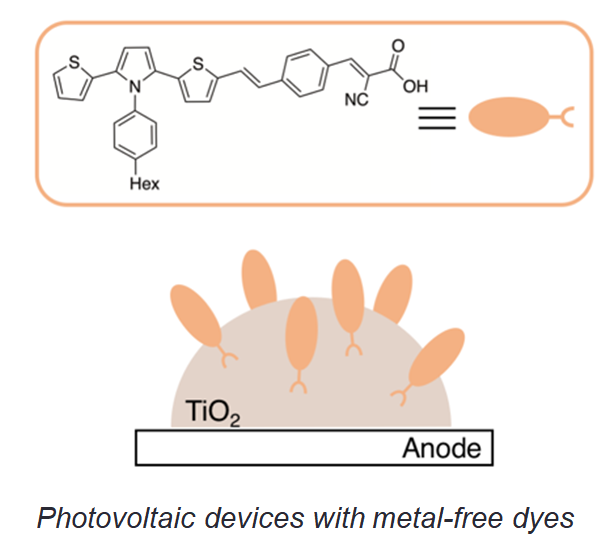This second sub-axis of research focuses on materials:
– development of metal complexes for photovoltaics,
– development of materials with hierarchical porosity,
– synthesis of metallic nanomaterials and metallic oxides.
֍ dispositifs photovoltaïques
Photovoltaic devices
Photovoltaic systems based on photosensitive organic molecules are a very promising alternative to conventional solar cells. In the DSSCs, the best studied examples, the dye plays a fundamental role and can be with or without metal:
֍ New iron-based photosensitizers (cf ANR Photiron)
ο Concept: replacing Ru by Fe is at first glance the perfect alternative (same group (metals d6), more abundant and non-toxic)
ο Problematic: in the case of Fe, injection is particularly problematic due to a rapid deactivation of MLCT-MC states due to the presence of low energy MC states, a phenomenon not observed with Ru complexes.
ο Solution: increase the stability of the excited MCLT state responsible for electron transfer by playing on the electron structure of iron complexes.
ο Proof of concept: obtaining iron complexes containing pyridylcarbene ligands with record lifetime
֍ Metal-free dye
ο Concept : use of condensed polyaromatic systems.
ο Objectives : obtaining dyes with good spectral coverage, especially in the visible and infrared, and associated electrochemical properties.
ο Implementation : introduction of semiconductor anchor groups (TiO2) and alkyl chains to modulate the solubility and performance of the device.
֍ porosite
Materials with hierarchical porosity
The laboratory, which has expertise in determining the relationships between the properties of surfactants (evolution of the phase behaviour in water related to temperature, oil solubilization capacity) and the characteristics of porous materials (organization, pore size, morphology), wishes to intensify its activities concerning their uses. The applications targeted are photocatalysis, catalysis and enzymatic catalysis.
energie
֍ Organized Molecular Systems for the development of porous materials and nano-structured hybrid materials with a silicate matrix or based on transition metal oxides.
ο Preparation of mesoporous titanium oxide (TiO2) by combining the synthesis conditions of the transcriptive mechanism (LCT) and the Evaporation induced self assembly (EISA) method.
– removal of gaseous pollutants from the air at industrial sites,
– application in catalytic hydrotreating processes (hydrodesulfurization, hydrodeoxygenation, hydrodeazotation),
– preparation of photovoltaic devices with TiO2 doping to reduce bandgap.
ο Application of the mesoporous TiO2 preparation mechanism to the synthesis of ZrO2, Al2O3 and MgO or to mixed oxides (catalytic application).
ο Synthesis of supported catalysts by deposition or in-situ incorporation of metallic nanoparticles (Fe, Co, Cu,…) in a mesoporous matrix (Si2O2, MgO, CeO2).
ο Synthesis of acid catalysts by development of micro-mesoporous zeolites obtained by desilication of the zeolite ZSM5 or by modification of the acidity and porosity of pillar clays.
catalyse
֍ Enzyme encapsulation in porous silicate matrices (meso, meso-meso et macro-meso): Elaboration of biocatalysts supported by enzyme immobilization.
ο Preparation of biocatalysts by immobilization of Mucor miehei lipase: use for the transesterification of vegetable oil (valorization by the production of bio-diesel).
ο Immobilization of acylases by use of innovative macroporous supports (Si(PHIPEs)), or meso-macroporoux (SBA15-Si(HIPEs)), monolithic or in beads: use for enzymatic acylation reactions (according to techno-functional and biological tests, use for the preparation of biosurfactant (cf ANR ISEAPIM3)
→ objective : to compete with Schotten-Baumann chemical acylation; establishment of a life cycle assessment (LCA).
֍ nanoparticules
Metallic nanoparticles and metallic oxides
The laboratory is also interested in the use of organometallic chemistry and coordination concepts for the preparation of metallic nanoparticles (NPs) and metallic oxides.
ο Methodology: development of original synthesis methods, obtaining nanomaterials of determined morphology and composition with specific physico-chemical properties and rationalization of the nucleation and growth mechanism of nano-objects.
ο Applications: from biology to catalysis by way of energy and environment
• antibacterial agents and/or theranostic agents
• development of nanostructured electrodes for:
– a use in spectroelectrochemistry
– the preparation of dye photovoltaic cells
• development of different categories of supported catalytic systems: on the surface of solids or inside the pores of porous solids.
to sub axis Heterocycles: Reactivity and Interaction
back to HeMaF





